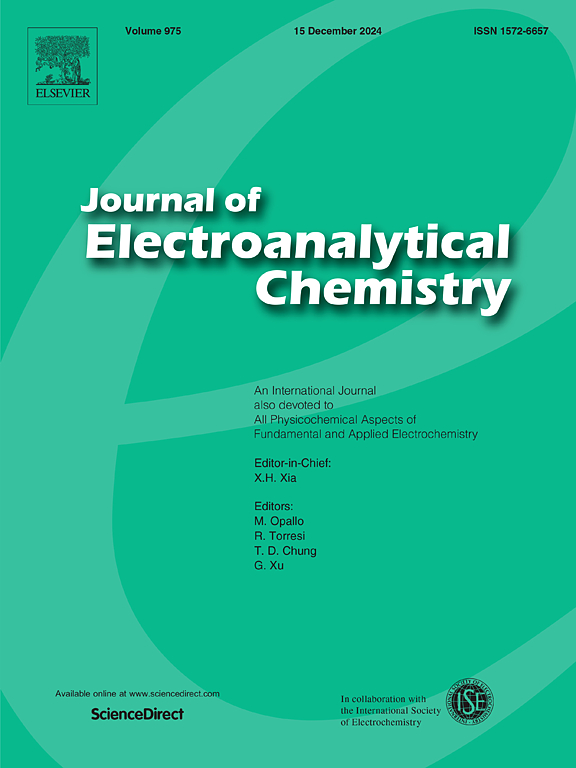Investigation of the electrochemical behaviour of praseodymium ions in a LiF-PrF3-Pr6O11 molten salt system
IF 4.1
3区 化学
Q1 CHEMISTRY, ANALYTICAL
引用次数: 0
Abstract
Understanding the electrochemical of paseodymium ions in molten salt is essential to improve electrolytic efficiency. To elucidate the electroreduction mechanism of praseodymium ions and overcome the limitations associated with regulating the yield of praseodymium metal in the industrial praseodymium electrolysis process, the electrochemical behaviour of praseodymium on the W working electrode surface in the LiF-PrF3-Pr6O11 molten salt system was determined by square–wave voltammetry, chronoamperometry, cyclic voltammetry and potentiometry analyses. The results indicated that the reduction of Pr3+ on the W cathode is a one-step quasireversible Pr3+/Pr reduction process controlled by diffusion of the LiF-PrF3 and (LiF-PrF3)eut-Pr6O11 electrolytes at 1223 K Pr3+ in the LiF-PrF3-Pr6O11 molten salt has a diffusion coefficient of DPr3+/Pr = 0.20 × 10−8–4.11 × 10−8 cm2·s−1. The incorporation of Pr6O11 increased the electrochemical activity of Pr3+ in the LiF-PrF3 system. Pr crystallization on the W electrode was achieved by three-dimensional progressive nucleation.
镨离子在 LiF-PrF3-Pr6O11 熔盐体系中的电化学行为研究
了解镨离子在熔盐中的电化学特性对于提高电解效率至关重要。为了阐明镨离子的电还原机理,克服工业镨电解过程中镨金属产率调节的局限性,研究人员通过方波伏安法、计时安培法、循环伏安法和电位计分析,确定了镨在 LiF-PrF3-Pr6O11 熔盐体系中 W 工作电极表面的电化学行为。结果表明,在 1223 K 时,LiF-PrF3 和 (LiF-PrF3)eut-Pr6O11 电解质中的 Pr3+ 在 LiF-PrF3-Pr6O11 熔盐中的扩散系数为 DPr3+/Pr = 0.20 × 10-8-4.11 × 10-8 cm2-s-1。在 LiF-PrF3 体系中,Pr6O11 的加入提高了 Pr3+ 的电化学活性。W 电极上的 Pr 结晶是通过三维渐进成核实现的。
本文章由计算机程序翻译,如有差异,请以英文原文为准。
求助全文
约1分钟内获得全文
求助全文
来源期刊
CiteScore
7.80
自引率
6.70%
发文量
912
审稿时长
2.4 months
期刊介绍:
The Journal of Electroanalytical Chemistry is the foremost international journal devoted to the interdisciplinary subject of electrochemistry in all its aspects, theoretical as well as applied.
Electrochemistry is a wide ranging area that is in a state of continuous evolution. Rather than compiling a long list of topics covered by the Journal, the editors would like to draw particular attention to the key issues of novelty, topicality and quality. Papers should present new and interesting electrochemical science in a way that is accessible to the reader. The presentation and discussion should be at a level that is consistent with the international status of the Journal. Reports describing the application of well-established techniques to problems that are essentially technical will not be accepted. Similarly, papers that report observations but fail to provide adequate interpretation will be rejected by the Editors. Papers dealing with technical electrochemistry should be submitted to other specialist journals unless the authors can show that their work provides substantially new insights into electrochemical processes.

 求助内容:
求助内容: 应助结果提醒方式:
应助结果提醒方式:


